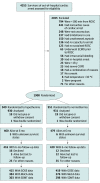Effects of Hypothermia vs Normothermia on Societal Participation and Cognitive Function at 6 Months in Survivors After Out-of-Hospital Cardiac Arrest: A Predefined Analysis of the TTM2 Randomized Clinical Trial
- PMID: 37548968
- PMCID: PMC10407762
- DOI: 10.1001/jamaneurol.2023.2536
Effects of Hypothermia vs Normothermia on Societal Participation and Cognitive Function at 6 Months in Survivors After Out-of-Hospital Cardiac Arrest: A Predefined Analysis of the TTM2 Randomized Clinical Trial
Abstract
Importance: The Targeted Hypothermia vs Targeted Normothermia After Out-of-Hospital Cardiac Arrest (TTM2) trial reported no difference in mortality or poor functional outcome at 6 months after out-of-hospital cardiac arrest (OHCA). This predefined exploratory analysis provides more detailed estimation of brain dysfunction for the comparison of the 2 intervention regimens.
Objectives: To investigate the effects of targeted hypothermia vs targeted normothermia on functional outcome with focus on societal participation and cognitive function in survivors 6 months after OHCA.
Design, setting, and participants: This study is a predefined analysis of an international multicenter, randomized clinical trial that took place from November 2017 to January 2020 and included participants at 61 hospitals in 14 countries. A structured follow-up for survivors performed at 6 months was by masked outcome assessors. The last follow-up took place in October 2020. Participants included 1861 adult (older than 18 years) patients with OHCA who were comatose at hospital admission. At 6 months, 939 of 1861 were alive and invited to a follow-up, of which 103 of 939 declined or were missing.
Interventions: Randomization 1:1 to temperature control with targeted hypothermia at 33 °C or targeted normothermia and early treatment of fever (37.8 °C or higher).
Main outcomes and measures: Functional outcome focusing on societal participation assessed by the Glasgow Outcome Scale Extended ([GOSE] 1 to 8) and cognitive function assessed by the Montreal Cognitive Assessment ([MoCA] 0 to 30) and the Symbol Digit Modalities Test ([SDMT] z scores). Higher scores represent better outcomes.
Results: At 6 months, 836 of 939 survivors with a mean age of 60 (SD, 13) (range, 18 to 88) years (700 of 836 male [84%]) participated in the follow-up. There were no differences between the 2 intervention groups in functional outcome focusing on societal participation (GOSE score, odds ratio, 0.91; 95% CI, 0.71-1.17; P = .46) or in cognitive function by MoCA (mean difference, 0.36; 95% CI,-0.33 to 1.05; P = .37) and SDMT (mean difference, 0.06; 95% CI,-0.16 to 0.27; P = .62). Limitations in societal participation (GOSE score less than 7) were common regardless of intervention (hypothermia, 178 of 415 [43%]; normothermia, 168 of 419 [40%]). Cognitive impairment was identified in 353 of 599 survivors (59%).
Conclusions: In this predefined analysis of comatose patients after OHCA, hypothermia did not lead to better functional outcome assessed with a focus on societal participation and cognitive function than management with normothermia. At 6 months, many survivors had not regained their pre-arrest activities and roles, and mild cognitive dysfunction was common.
Trial registration: ClinicalTrials.gov Identifier: NCT02908308.
Conflict of interest statement
Figures


References
-
- Nolan JP, Morley PT, Vanden Hoek TL, et al. ; International Liaison Committee on Resuscitation . Therapeutic hypothermia after cardiac arrest: an advisory statement by the advanced life support task force of the International Liaison Committee on Resuscitation. Circulation. 2003;108(1):118-121. doi:10.1161/01.CIR.0000079019.02601.90 - DOI - PubMed
-
- Nolan JP, Soar J, Cariou A, et al. . European Resuscitation Council and European Society of Intensive Care Medicine Guidelines for Post-resuscitation Care 2015: Section 5 of the European Resuscitation Council guidelines for Resuscitation 2015. Resuscitation. 2015;95:202-222. doi:10.1016/j.resuscitation.2015.07.018 - DOI - PubMed
Associated data
LinkOut - more resources
Full Text Sources
Medical

